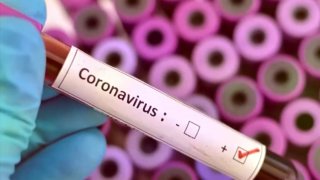
State health officials Saturday released new guidance to educational institutions, event organizers and local public health officials regarding the further spread of coronavirus, outlining possible scenarios and resultant measures to be taken.
"It's a question of when -- not if -- some California public schools will face closure because of COVID-19,'' Gov. Gavin Newsom said in a written statement. "School districts must prepare for these scenarios so that parents and children can plan for what would happen if their local school faced closure."
As of 10 a.m. Saturday morning, there were 88 confirmed COVID-19 cases statewide, according to the California Department of Public Health.
"It's also not lost on anyone that these scenarios would put significant stress on families -- especially those with the least financial resources,'' Newsom said.
"Already, we are seeing how this outbreak is having significant economic impact on families, workers, businesses and communities across California. The state of California is working around the clock to help shoulder the burden that Californians are facing during this crisis. We really are all in this together," he said.
The new guidelines issued by the California Department of Public Health consist of separate lists of scenarios for schools, colleges/universities and large public events.
For schools, there are four scenarios, the first of which includes measures already in place to stop the further spread of the illness. These are:
-- Review and update comprehensive school safety plans, including continuity plans for teaching and learning if students are absent from school;
-- Exclude students, teachers or staff who have a travel history over the course of the last 14 days to an area identified by the CDC as Level 3 Travel Health Notice; additionally, exclude those who have been in close contact with someone diagnosed with COVID-19 from the school for 14 days from the day of their last exposure;
-- Send students, teachers and staff who present fever and/or respiratory infection symptoms home immediately -- separate them from others until they go home and when feasible, identify a "sick room" through which others do not regularly pass;
-- Coordinate with all partner organizations serving students to ensure consistent practices;
-- Encourage flu vaccine for those persons over 6 months of age who have not had it this season;
-- Develop a plan to communicate with the school community;
-- Contact your county emergency operations center if it has been established or your local public health department immediately if you notice any concerning clusters of respiratory disease or spikes in absenteeism;
-- Encourage all students, families and staff to take everyday preventive actions: Stay home when sick, remain at home until fever has been gone for at least 24 hours without the use of fever-reducing medicines, seek immediate medical care if symptoms become more severe -- high fever, difficulty breathing -- use "respiratory etiquette" by covering cough with a tissue or sleeve.
U.S. & World
The second scenario consists of measures to be taken if there are two or more community transmission cases of COVID-19, but no individuals within the school test positive. In such a situation, the Scenario 1 guidelines would remain intact and the following steps are recommended:
-- Teachers and staff with any fever and/or respiratory infection symptoms should not come to work; teachers and staff should self-screen -- check themselves for subjective fever and/or respiratory symptoms such as cough
-- each morning before interacting with students;
-- Ensure sick leave policies for those allow teachers and staff to stay home if they have symptoms of respiratory infection;
-- Limit visitors to the school by not allowing those with symptoms of fever and/or respiratory infection or who have a travel history over the course of the last 14 days to an area identified by the CDC as Level 3 Travel Health Notice;
-- Consider alternates to congregate or group programming within the school, including any large or communal activities such as assemblies;
-- Alternate approaches which limit close contact may include conducting assemblies via webcasts or intercom announcements;
-- Consider implementing staggered recess times to limit the number of students who are together and if possible, group recess by classrooms;
-- Consider relaxing requirements for a doctor's note for the child to return to school after illness.
Scenario 3 are measures to be taken if one student, teacher or staff member tests positive for COVID-19 and exposed others at the school. In that case, CDPH recommends:
-- In consultation with the local public health department, the appropriate school official may consider if school closure is warranted, and length of time based on the risk level within the specific community as determined by the local public health officer;
-- In consultation with the local public health department, school officials may determine re-admission criteria after the school closures;
-- Implement communication plans for school closure to include outreach to students, parents, teachers, staff and the community -- include information for parents regarding labor laws, information regarding disability insurance, paid family leave and unemployment insurance;
-- Provide guidance to parents, teachers and staff reminding them of the importance of community social-distancing measures while school is closed, including discouraging students or staff from gathering elsewhere -- community social-distancing measures include canceling group activities or events, religious services, after-school classes and sporting events;
-- Consider developing a plan for continuity of education, medical and social services, and meal programs and establish alternate mechanisms for these to continue -- meal programs can continue to offer meals when school is closed;
-- Consult CDC guidelines for schools to determine what additional cleaning protocols, if any, should be deployed at the school prior to reopening the school;
-- Determine the timing of return of students and staff, and any
additional steps needed for the school to reopen, in consultation with the
local public health department.
The final scenario is a list of measures to be taken if multiple schools within a school district have a student, teacher or staff member test positive for COVID-19. In this scenario, the school administrator should consult with local public health officials for guidance on additional school closures. If it is determined that all schools within the school district should be closed for instruction, the department recommends:
-- Consultation with the local public health department, the school administrator may determine if additional school closures are necessary and what length of time is warranted based on the risk level within the specific community as determined by the local public health officer;
-- Develop communication plans for school closure to include outreach to students, parents, teachers, staff and the community;
-- Provide guidance to parents, teachers and staff, reminding them of the importance of community social-distancing measures while school is closed, including discouraging students or staff from gathering elsewhere -- community social-distancing measures include canceling group activities or events, religious services, after-school classes and sporting events;
-- Consider developing a plan for continuity of education, medical and social services, and meal programs and establish alternate mechanisms for these to continue;
-- Maintain regular communications with the local public health department;
-- Work with the local public health department to determine what additional cleaning protocols, if any, should be deployed at the school prior to reopening the school;
-- Determine the timing of return of students and staff, and any additional steps needed for the school to reopen, in consultation with the local public health department.
The CDPH and California Department of Education urge schools to ensure student and staff privacy to help prevent discrimination or unnecessary stigmatization. For additional information or questions regarding medically fragile populations, programs or funding implications, contact the CDE.



